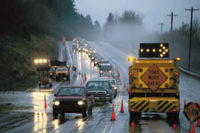How to bolster nighttime visibility in highway work zones

For motorists and the workers who build, repair, and maintain streets, bridges, and highways, roadway work zones can be dangerous. In these areas, a variety of complicated road signs, barrels and lane changes could increase the risk of motor vehicle crashes.
According to the Federal Highway Administration, 24,745 people died between 1982 and 2015 in motor vehicle crashes in construction and maintenance work zones. This equates to 750 deaths per year. Although the number has declined from 2008–2014 to a yearly average of 581, roadway work zones still present risks to workers and others.
Flashing lights are key
To prevent crashes in work zones, safety equipment, such as flashing yellow warning beacons, is critical. These lights aim to get motorists’ attention as they approach or drive through work zones and to alert them of potential hazards and nearby workers. Current standards for warning beacons include a minimum light intensity to ensure risks are seen, but do not identify a maximum degree of light intensity to protect against glare or distraction. The standards also do not differ between daytime and nighttime conditions, despite research showing the need for less light intensity at night.
In a NIOSH-supported study published in Accident Analysis & Prevention, scientists at Rensselaer Polytechnic Institute recently explored the effect of varied light intensities and other factors on motorists’ ability to detect workers while approaching work zones and warning beacons. Additional factors included how frequently the warning beacons flashed and whether or not workers wore high-visibility, reflective safety clothing.
Testing with cardboard workers
Scientists conducted this nighttime field study on a test track with four life-sized, cardboard workers—two with and two without reflective vests—positioned alongside the track lit with warning beacons. Non-reflective gray spray paint simulated dark clothing. Study participants included seven females and seven males ranging in age from 18 to more than 60 years. The drivers operated the same vehicle equipped with a device to record information, such as driving speeds and the distance at which they saw the simulated workers, related to various warning beacon light intensities and flash frequencies.
The recorded information showed that visibility was greatest at night when the warning beacons had light intensities (max/min) of 25/2.5 candelas (cd) and 150/15 cd, and flash frequencies of either 1 hertz (Hz) or 4 Hz. In other findings, reflective vests enabled the drivers to see the simulated workers at the farthest distance tested, regardless of the frequency and intensity of the warning beacons. These results apply only to nighttime conditions and could help protect workers by increasing visibility in roadway work zones.
More information is available:
Looking for a reprint of this article?
From high-res PDFs to custom plaques, order your copy today!





